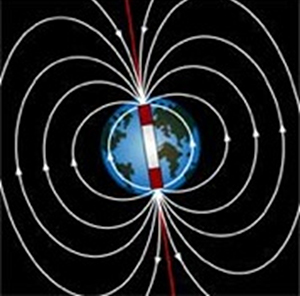
Credit: Paulo Marcelo Pontes (CC BY-SA 4.0 [https://creativecommons.org/licenses/by-sa/4.0]), via Wikimedia Commons
Many animals have a sixth sense that we humans do not. It’s called magnetoreception, and it allows them to read Earth’s magnetic field to navigate.
The magnetic field comes out of the ground at the South Magnetic Pole, flows parallel to the surface across the equator, then dives back into the ground at the North Magnetic Pole.
Many bacteria, earthworms, and blind mole rats can sense the direction of this magnetic field and orient to it. We call this compass sense.
Migrating animals like butterflies, salmon, sea turtles, and many birds have a more advanced version called signpost sense. They read the direction and inclination of the magnetic field and create mental maps of local anomalies, or “signposts” within it, to chart their paths in three dimensions over great distances.
Scientists who study magnetoreception have found that some bacteria have particles of magnetite that align north–south. Some birds have proteins in their eyes sensitive to magnetic fields.
But for the more complex signpost sense, animals must have multiple magnetic receptors sending diverse signals that converge in the brain. And we still don’t know what those are or how they work.
One reason we may not understand magnetoreception is that we simply don’t know what it feels like, so we’re not quite sure how to study it.
We’ll look at other “sixth senses” of the animal kingdom in future episodes.
Background
Synopsis: Many of Earth’s creatures—from microbes to insects, birds, and other vertebrates—are able to navigate using a sixth sense: magnetoreception. Humans don’t have this directional sense, so the phenomenon is hard for us to understand.
- Magnetoreception allows organisms to orient themselves and to navigate by detecting the direction, intensity, and inclination of a magnetic field.
- Earth’s magnetic field flows along a curved path from the South Magnetic Pole to the North Magnetic Pole. It is strongest at the poles and weakest at the magnetic equator.
- The inclination of Earth’s magnetic field varies, including running steeply out of the ground at the South Pole, parallel to the ground at the equator, or steeply into the ground at the North Pole.

Credit: NOAA Scijinks
- Creatures use the magnetic field to navigate in at least two ways:
- Compass sense: Some organisms—like bacteria, earthworms, and blind mole rats—use magnetic-field information as an internal compass, working out their orientation and adjusting their path according to magnetic-field direction.
- Signpost sense: Some organisms—like butterflies, salmon, spiny lobsters, sea turtles, and homing pigeons—appear to use the combination of magnetic polarity, intensity, and inclination to chart their paths. Some may even use unique combinations of local anomalies in the magnetic field as signposts in a mental map that gets them to their intended destination during migration and homing.
- Since humans don’t have this directional sixth sense, we simply don’t know what it would be like to perceive magnetic fields and so aren’t even sure where to start to look for the receptors.
- Different species may have evolved different ways of receiving and processing magnetic information to serve their specific directional needs.
- The only proven mechanism for magnetoreception is demonstrated in magnetotactic bacteria, which contain nanoparticles of magnetite and iron sulfide that align in parallel, enabling the bacteria to orient themselves and migrate along Earth’s magnetic-field lines.
- Researchers have discovered that proteins located in the eye called cryptochromes are sensitive to magnetic fields and may provide the simpler north–south compass sense for many organisms. These proteins also occur in human eyes, but we don’t appear to use them for directional sensing.
- Scientists believe the more complex signpost sense (which combines polarity with inclination and intensity) must use multiple receptor sites to provide a range of magnetic data types that converge in the brain. Most studies have focused on beaks or snouts as the likely location of these additional receptors.
- Magnetic fields pass directly through biological tissues, so the receptors could be anywhere in the organism, either clustered together or spread out.
- The mysterious mechanisms for magnetoreception are the subject of extensive scientific research and are designated as a grand challenge for sensory biology.

